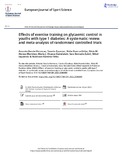Effects of exercise training on glycaemic control in youths with type 1 diabetes: a systematic review and meta-analysis of randomised controlled trials
Fecha
2022Autor
Versión
Acceso abierto / Sarbide irekia
Tipo
Artículo / Artikulua
Versión
Versión publicada / Argitaratu den bertsioa
Identificador del proyecto
Impacto
|
|
10.1080/17461391.2022.2086489
Resumen
The aim of the study is to evaluate whether exercise interventions are associated with improved
glycaemic control in children and adolescents with type 1 diabetes mellitus (T1DM), and to
examine its relationship with the characteristics of the intervention (i.e. type, intensity, length,
and duration of the sessions). Eligible criteria were randomised controlled trials of youth aged 6–
18 year ...
[++]
The aim of the study is to evaluate whether exercise interventions are associated with improved
glycaemic control in children and adolescents with type 1 diabetes mellitus (T1DM), and to
examine its relationship with the characteristics of the intervention (i.e. type, intensity, length,
and duration of the sessions). Eligible criteria were randomised controlled trials of youth aged 6–
18 years with T1DM, participating in an exercise-based intervention where glycaemic control is
measured (i.e. glycated haemoglobin [HbA1c]). Pooled effect sizes (Hedges’g) were calculated
using random-effects inverse-variance analyses. Fourteen studies enrolling 509 patients were
analysed. Effect size was expressed as Hedges’ g to correct for possible small sample bias. Overall,
HbA1c levels in the exercise group (g = –0.38 95% confidence interval [CI], –0.66 to –0.11; mean
difference [MD] = –0.62%) were reduced compared with the control group. Concurrent training (g
= –0.63 95%CI, –1.05 to –0.21), high-intensity exercise (g = –0.43 95%CI, –0.83 to –0.03),
interventions ≥24 weeks (g = –0.92 95%CI, –1.44 to –0.40), and sessions ≥60 minutes (g = –0.71
95%CI, –1.05 to –0.08) showed larger changes (MD = –0.66% to 1.30%). In conclusion, our study
suggests that programmes longer than 24 weeks with at least 60 min/session of high-intensity
concurrent exercise may serve as a supportive therapy to metabolic control in youth with T1DM. [--]
Materias
Type 1 diabetes mellitus,
Glycaemic control,
Exercise,
Aerobic,
Resistance
Editor
Taylor & Francis
Publicado en
European Journal of Sport Science, 2022
Departamento
Universidad Pública de Navarra. Departamento de Ciencias de la Salud /
Nafarroako Unibertsitate Publikoa. Osasun Zientziak Saila
Versión del editor
Entidades Financiadoras
This study was funded by grant PI21/01238 from the Instituto de Salud Carlos III (Spain). Dr. García-Hermoso is a Miguel Servet Fellow (Instituto de Salud Carlos III - CP18/0150). The project that gave rise to these results received the support of
a fellowship from la Caixa Foundation granted to Nidia Huerta Uribe (ID 11780038).
Aparece en las colecciones
Los documentos de Academica-e están protegidos por derechos de autor con todos los derechos reservados, a no ser que se indique lo contrario.
La licencia del ítem se describe como © 2022 The Author(s). This is an Open Access article distributed under the terms of the Creative Commons Attribution-NonCommercial-NoDerivatives License which permits non-commercial re-use, distribution, and reproduction in any medium, provided the original work is properly cited, and is not altered, transformed, or built
upon in any way.







